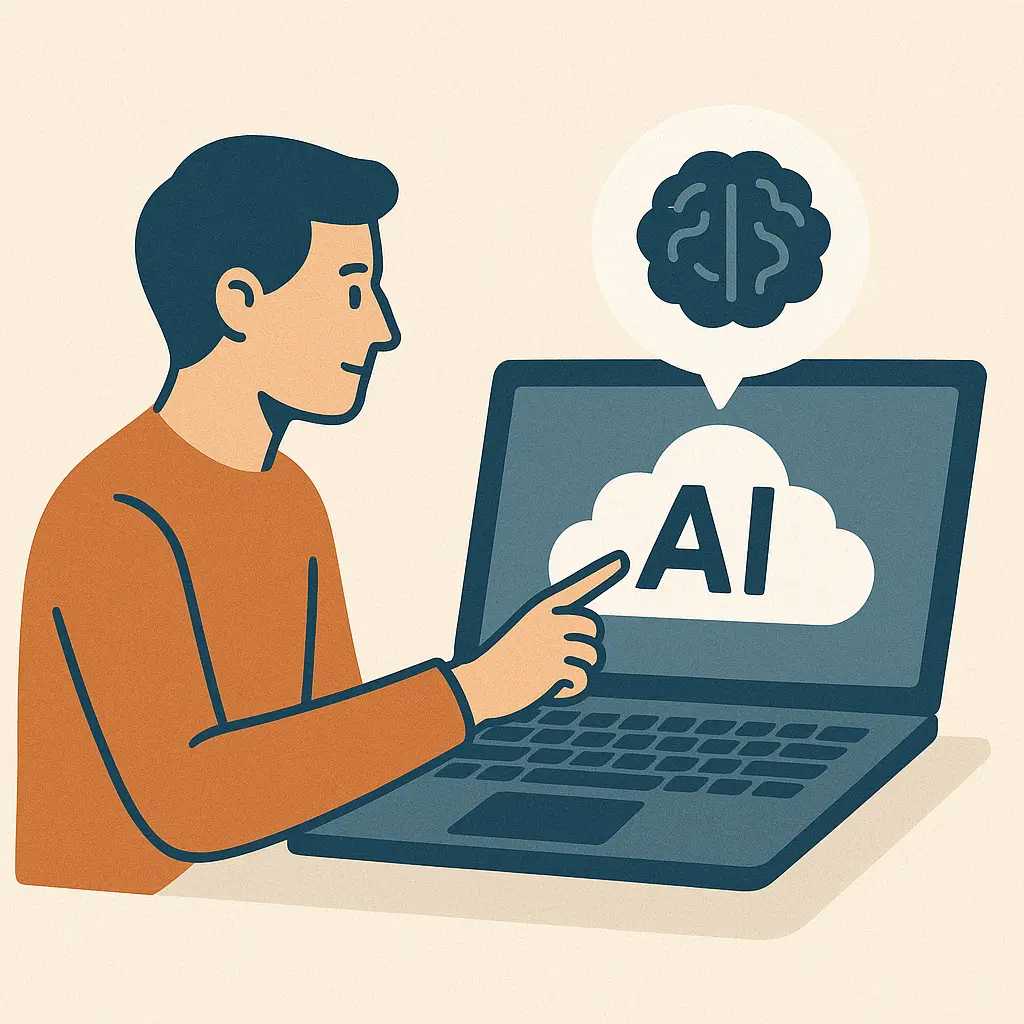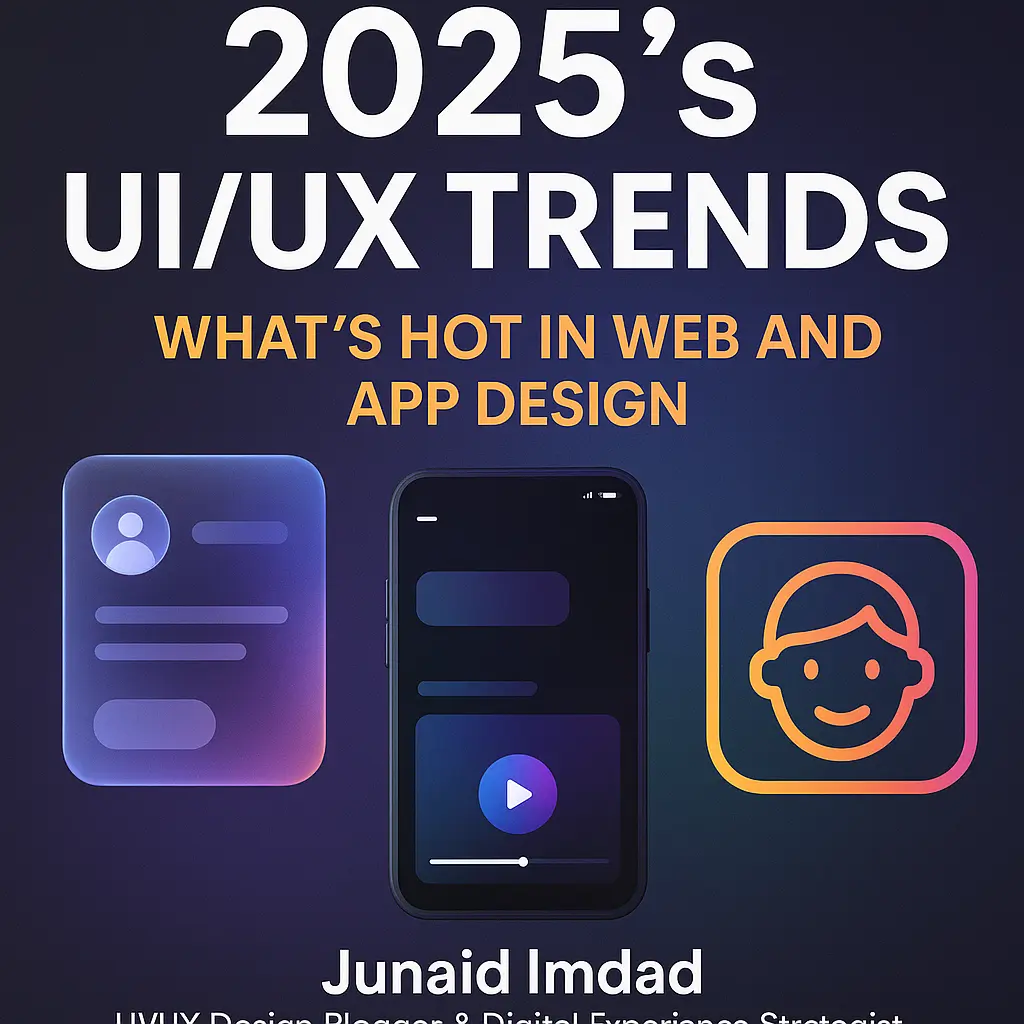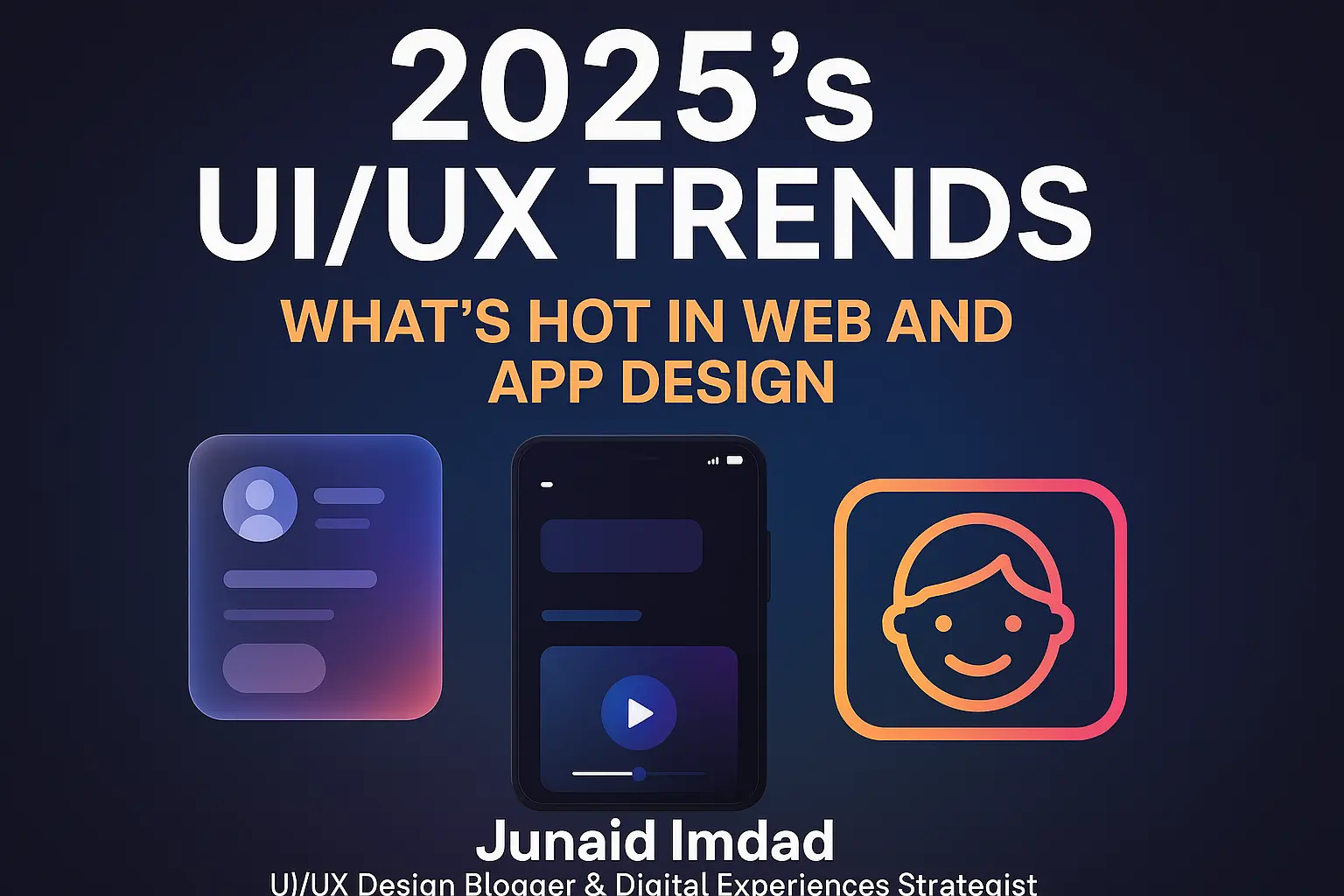By Junaid Imdad, Blogger & Digital Experience Strategist
User interface and user experience design have always been at the cutting edge of digital evolution. Nowadays, Web and App Design trends are changing faster than ever, influencing how we engage with apps and websites. Keeping up with these design trends isn’t just a nice-to-have anymore; for small businesses, startups, and larger enterprises, it’s essential for thriving in a world that’s increasingly focused on the user.
As a UI/UX blogger with five years of real-world experience, I’ve witnessed countless design trends come and go. However, 2025 is shaping up to be a pivotal year—a time characterized by technological advancement and a strong emphasis on human-centered design. In this post, I’ll share the top five UI/UX design trends for 2025 that are not only making Web and App Design look sleek and modern but also ensuring it feels intuitive, inclusive, and truly meaningful for real users.
1. Hyper-Personalized User Experiences
Gone are the days when “one size fits all” was the norm. By 2025, personalization has transformed from a nice-to-have into something users expect. Thanks to the rise of AI and machine learning, today’s web and app design is all about creating real-time, adaptive experiences. These smart technologies dive into user behaviors, preferences, and past interactions to predict what people need—often before they even know it themselves. Whether it’s tailored UI layouts, personalized product recommendations, or content suggestions, hyper-personalization is quickly becoming the gold standard for crafting meaningful digital experiences.
Example:
- Dynamic content that takes into account past behavior and predictive analytics
- Customized onboarding flows that adjust in real-time
- Custom dashboards that change with user preferences
Why It Matters:
Personalized experiences are truly the backbone of effective Web and App Design in 2025. By customizing content, layout, and features for each user, businesses are witnessing remarkable boosts in retention, engagement, and conversion rates. When users feel genuinely recognized, understood, and appreciated, they’re much more inclined to come back and engage with your product. This feeling of personal connection builds long-lasting loyalty, turning casual visitors into passionate brand supporters. Whether it’s through adaptive interfaces, tailored onboarding, or personalized content suggestions, personalization is more than just a passing trend—it’s a key competitive edge.
2. Dark Mode 2.0
While dark mode has been around in web and app design for quite some time, by 2025, it’s set to become something much smarter. These days, dark modes are not just about looking good—they’re all about being adaptable. Designers are tapping into sensors and user behavior data to craft dark modes that automatically adjust based on the time of day, the lighting around you, and your personal preferences. This results in a smoother and more enjoyable experience, particularly for those late-night browsers or anyone in dimly lit spaces. In the world of modern UI/UX, dark mode has evolved from a simple switch to a dynamic design element that boosts usability and accessibility.
What’s New? Context-aware themes that move between warm and cool tones.
Smart contrast systems help ensure legibility across devices.
Brand-integrated dark palettes that feel cohesive and accessible.
Pro Tip: Don’t consider dark mode just another checkbox feature; think of it more as an additional layer of user empathy and visual ergonomics.
3. Voice-Activated Interfaces
Voice UI technology is making huge strides, moving beyond just smart speakers and virtual assistants to become a key player in modern web and app design. By 2025, we can expect voice navigation and command features to be essential components of websites and mobile apps, allowing for hands-free and efficient interactions. This shift is about more than just convenience; it’s also about making technology more inclusive. For users who are visually impaired or those who are multitasking—like driving or cooking—voice interfaces offer a more accessible and streamlined way to engage with digital products. As natural language processing continues to improve, we’re stepping into a time where chatting with your app feels as natural as tapping on it.
Use Cases: Throughout e-commerce: “Please show me blue shoes under $100.”
Voice-activated search and navigation in content-rich apps is now possible with voice activation technology.
Conversational onboarding using AI chatbots
Impact on UX: Voice UI is all about making user journeys quicker and more accessible, while also promoting inclusivity by providing different ways to interact. In today’s web and app design, this translates to creating interfaces that respond to voice commands just as smoothly as they do to touch or clicks. For individuals with disabilities or those who are busy with their hands, voice interfaces offer a hassle-free way to connect with digital platforms—shattering old accessibility barriers and improving the overall user experience. As voice technology continues to evolve, it’s becoming a fundamental part of inclusive and innovative design strategies for 2025.

4. 3D and Engaging Visuals
As 3D design, AR (Augmented Reality), and WebGL experiences continue to merge the physical and digital worlds, the lines between reality and virtuality are becoming more blurred. In today’s web and app design landscape, this evolution isn’t just a passing trend—it’s quickly becoming standard practice. By 2025, users will be looking for immersive, three-dimensional, and interactive interfaces that mimic the depth and motion of the real world.
Whether it’s showcasing a product through AR, offering a 3D walkthrough, or engaging in interactive storytelling with WebGL, these technologies are transforming how we interact with digital content. Designers are now prioritizing realism, spatial awareness, and a seamless experience to make apps and websites feel more like vibrant environments rather than just static screens.
Example
- Product Visualization with 360deg rotation and zoom capability.
- Augmented reality try-ons (glasses, furniture and makeup) provide users with a virtual way of testing out various items (glasses, furniture and makeup).
- Engaging infographics and data dashboards.
Why it’s popular: Visuals like these help users engage more deeply and make more confident decisions, which is especially crucial in industries such as e-commerce, education, and gaming. In modern web and app design, immersive 3D elements and AR interactions are not just aesthetic enhancements—they serve strategic purposes. For online shoppers, being able to visualize a product in their environment increases purchase confidence. In educational platforms, interactive visuals simplify complex concepts and improve retention. For gaming, hyper-realistic design deepens immersion and boosts user satisfaction. The more intuitive and lifelike the interface, the more likely users are to trust, interact with, and return to the platform.
If you want to get info about gamification in SEO, simply click on it.
5. Micro Interactions for Purpose
Microinteractions—those little animations or visual cues that pop up when you take an action, like liking a post, clicking a button, or getting a notification—have really come a long way in 2025. They’re not just there for show anymore; these tiny design moments are now crafted with intention and focus on the user. Designers are leveraging microinteractions to steer user behavior, convey system status, and create enjoyable experiences without bombarding the user. For example, a gentle pulse on a “submit” button can signal that everything went smoothly, while a soft shake might indicate something went wrong. These subtle interactions are essential in today’s web and app design, improving usability, fostering emotional connections, and quietly reinforcing brand identity.
Example 1: Plotting progress indicators with real-time feedback
Take advantage of ripple effects and button animations to improve focus.
Visual cues during form submission or drag-and-drop are helpful when completing forms or dropping.
Best Practice: To really make an impact, microinteractions need to do more than just look pretty. Each little animation, haptic feedback, or visual cue should actually help users and clear up any confusion. Whether it’s confirming an action, showing system status, or guiding users to the next step, these interactions should feel natural and informative. If they miss the mark, they can turn into just visual clutter—more distracting than enjoyable. In today’s web and app design landscape, well-designed microinteractions are essential for building trust, boosting engagement, and ensuring a smooth user experience.
6. Emotional Design and Empathy Mapping
In 2025, designing with empathy isn’t just a nice-to-have; it’s a must. Emotional design goes beyond mere usability; it strives to stir genuine feelings and create experiences that truly resonate with people. Whether it’s a soothing animation, comforting words, or a user-friendly layout, empathetic design forges an emotional connection with users, fostering trust and loyalty. In the realm of web and app design, this means really getting to know users’ needs, frustrations, and motivations, and then creating interfaces that not only tackle their problems but also make them feel heard, valued, and understood.
Techniques: Empathy maps to gain a comprehensive understanding of user pain points, goals and contexts
Emotionally intelligent copywriting (e.g., error messages that comfort)
Celebration animations for goal completion (e.g., throwing confetti when tasks are complete).
Why it Matters: When products feel humanized, users connect emotionally – and emotions drive decisions more decisively than logic.
7. Glassmorphism and Neo-Brutalism
In the world of Web and App Design for 2025, we’re seeing two unique visual styles emerging, each tailored to different user experiences and brand vibes. Glassmorphism brings a touch of the future with its soft transparency and elegant layering, crafting a lightweight and sophisticated interface. Meanwhile, Neo-Brutalism is making a striking return, showcasing bold typography, stark layouts, and a no-nonsense focus on content over embellishment. This contrast really shows how designers are skillfully balancing subtlety and boldness to resonate with a wide range of audiences.
Glassmorphism Features:
- Simplify user interaction through transparent user interface layers that have background blur.
- Frosted card elements appear floating across visuals.
- Layered interfaces that combine depth and minimalism
- Neo-Brutalism Elements: High-Contrast Color Schemes
- Bold fonts with large text.
- Grid-breaking layouts with minimal visual polish.
Where they work best: Glassmorphism works great in dashboards and financial apps. Neo-Brutalism works best in landing pages, creative portfolios or bold brand statements.
8. AI-Generated Components
AI tools in 2025 have come a long way from being just a fun gimmick; they’ve truly become essential creative allies for today’s designers. In the realm of Web and App Design, these tools have moved past merely automating minor tasks. Now, AI-powered platforms play an active role throughout the entire design process—from crafting layouts and color schemes to testing usability and fine-tuning user flows—making everything smarter, quicker, and more adaptable.
With capabilities like auto-generating responsive layouts and dynamically adjusting interfaces for various screen sizes and accessibility requirements, AI is transforming Web and App Design in 2025. Designers are now able to work more intelligently, efficiently, and inclusively than ever before. Cutting-edge algorithms can recommend design enhancements based on real-time interaction data, automatically run A/B tests on visual elements, and even perform usability testing with virtual users—all before a product is launched. This shift not only boosts efficiency but also elevates the overall user experience right from the get-go.
This AI-driven approach allows designers to concentrate more on strategy, storytelling, and emotional connection, while the routine production tasks are seamlessly managed in the background. In 2025, the finest web and app designs aren’t just crafted by humans; they’re the result of collaboration between humans and AI, leading to smarter, more user-focused experiences.
Popular Tools:
- WIP Figma AI Assistant provides layout and copy suggestions.
- Wizard and Framer AI provide fast prototyping.
- Adobe Firefly for visual content creation and mockups
Benefits: Shorter feedback loops, smarter iterations, and democratized tools are the hallmarks of success in Web and App Design user research. In 2025, effective user research means rapid testing, continuous improvement, and empowering even non-designers to contribute meaningful insights to both web and mobile experiences.

9. Inclusive and Accessible Design Standards
Accessibility in 2025 isn’t just about ticking boxes anymore; it’s become a crucial part of what makes a product or service successful. In today’s world of Web and App Design, making sure that users of all abilities can fully engage with digital platforms is a must-have standard. Embracing inclusive design practices not only improves usability for everyone but also showcases a brand’s dedication to fairness and empowering its users.
Key Features of Our Software Solution:
[IASC/CAPTITALE/WVEC] (Captioned Video and Audio Content)
- Optimize screen reader optimization using semantic HTML
- Focus indicators and keyboard-friendly navigation make for clear navigation.
- Tools of Choice for Accessibility Audits: Stark (Figma plugin), DevTools and Lighthouse
Why it matters: Accessible design makes your app accessible to millions more users while safeguarding against legal risks and adhering to ethical best practices.
10. Elimination of All User Interfaces and Invisible Interconnections
We have entered an age of ambient computing, where Web and App Design extends beyond screens—devices now anticipate user needs and act even without traditional visual interfaces.
Application Areas: for gesture controls on wearable devices
Smart homes feature environmental triggers to automate certain functions.
Proactive notifications from IoT devices
Trend Insight: Zero user interface design creates magical experiences that feel intuitive and frictionless—an exciting frontier in Web and App Design, especially for smart tech ecosystems.
Bonus Trend: Sustainable Design in Design
In the world of Web and App Design for 2025, sustainability has taken center stage—not just in our physical spaces, but in the digital ones too. Designers are now making a concerted effort to optimize websites and apps to cut down on energy use, minimize unnecessary data transfers, and boost overall efficiency. We’re seeing everything from lightweight coding frameworks to darker UI themes that help save screen energy. Eco-friendly design practices have moved from being a nice-to-have to an absolute must. This change highlights a growing awareness that even our digital experiences contribute to our carbon footprint, and tackling that impact is now a key part of responsible, forward-thinking design.
Techniques:
- Optimized media files and reduced server requests are two techniques used to increase media file efficiency.
- Code simplification that reduces load times
- System-wide dark themes to conserve OLED display power.
Sustainable Web and App Design not only helps protect our planet—it also enhances website performance, reduces hosting and energy costs, and demonstrates a brand’s commitment to social responsibility.
Final Remarks: Focusing on Design for People, Not Screens
Trends can be a great source of inspiration in Web and App Design, particularly in the UI/UX fields, but they shouldn’t be seen as strict rules. The essence of outstanding design is rooted in a genuine understanding of users—their needs, behaviors, and challenges. Exceptional UI/UX design goes beyond just looking good or following the latest fads; it’s about addressing real issues and creating intuitive, enjoyable digital experiences that truly connect with people. Real innovation stems from empathy, thorough research, and ongoing refinement—not merely chasing after trends.
As you implement these UI/UX trends for 2025, make sure that innovation meets empathy. Technology should serve people not the other way around!

As a designer, agency, or tech founder, embracing these Web and App Design trends means you’re not just keeping up with 2025, you’re future-proofing your digital presence for the years ahead. By aligning with evolving user expectations, accessibility standards, and AI-powered tools, you ensure that your products remain relevant, engaging, and impactful in an ever-changing digital landscape.
Need assistance aligning your product with these cutting-edge trends? Let’s connect.
By Junaid Imdad, Blogger & Digital Experience Strategist




How Much Will it Cost to Build a Mobile App in 2025? - Devitcity
[…] you want to get info about UI/UX design, simply click on […]
Do You Really Require Chatbots or Conversational AI on Your Website? - Devitcity
[…] you want to get info about UI/UX design trends, simply click on […]
Cybersecurity in Web Development: 2025 Threats and How to Protect Your Site - Devitcity
[…] you want to know about UI/UX trends, simply click on […]
AI-Powered Web Design: How AI Tools Are Revolutionizing Website Development - Devitcity
[…] tools that improve UX/UI based on heatmaps or behavioral […]
What is SXO? SEO in 2025 - Devitcity
[…] UX (User Experience): Engaging and Retaining Users through Innovative Designs and Usabilities […]
Successfully Launching Your First Mobile App in 2025: A Step-by-Step Guide - Devitcity
[…] Dive deeper with: UI/UX Trends for 2025 […]